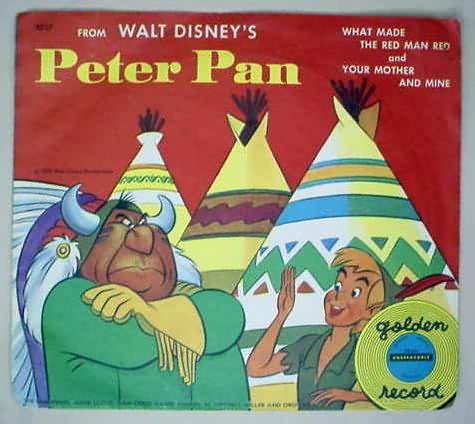Eric Haywood @Eric_Haywood
Something’s odd about this new Peter #Pan movie, but I just can’t put my finger on it. #TigerLily

Here are some excellent analyses of the ongoing problems with the upcoming Pan movie:
Rooney Mara's Tiger Lily Could Not Be Less Native. That's a Problem.
A poster and movie trailer for Pan, the Peter Pan prequel planned for a summer 2015 release, is giving the public a first glimpse of actress Rooney Mara in the role of Tiger Lily, a Native American character in J.M. Barrie's 1904 play. The visuals have reignited the controversy that broke out in March over the casting of Mara, a non-Native actress, in the role. Reporting on the choice touted the film's "multi-racial" world and "a very different [Tigerlily] than was originally imagined."
But there was concern and even outrage over Mara's casting. An online petition was started to urge Warner Brothers to "Stop casting white actors to play people of color!" On Twitter and other social media, many people voiced disappointment in Mara for accepting the role.
In our our earlier coverage of this issue, we saw two possible explanations of the casting choice. One was simply the old Hollywood practice of casting white actors as Indians—the traditions of "whitewashing" (casting well-known white actors in Native roles to ensure ticket sales) and "redface" (white actors playing Indians, often by invoking common stereotypes) that have been common from the silent-film era up through Johnny Depp's Tonto in 2013. We entertained another explanation, though: that the filmmakers, concerned by the racist portrayal of Natives in Peter Pan—and it's really bad, particularly in the 1953 Disney film—were trying to avoid repeating it. After all, many ICTMN readers have commented that the character of Tiger Lily is an inherently racist creation, and that Mara might as well take it because no self-respecting Native actress should have to reinforce the stereotype for the sake of a blockbuster credit.

The Chief in Pan is played by Jack Charles, a famous Australian Aboriginal actor. Here's what he looks like:

And yes, we're braced for the "revelation" of the plot twist that Mara's Tiger Lily came to Neverland from England before Peter did, and was adopted by the Chief. We can see that one coming a mile away. That doesn't negate the cynical nature of Mara's casting, just shows the filmmakers felt they had write an explanation into the storyline.
From Debbie Reese's American Indians in Children's Literature blog:
How 'bout we all pan NBC's PETER PAN and Warner Bros PAN, too
"The little one. He wears the pan."
Here's a screen capture of that scene in the trailer:

Here she is in that moment:

Some of you know that there was a lot of discussion when Rooney was selected as the actress for the part. Many people said that a Native actress ought to be cast instead of Rooney. I disagree with that idea, too.
Fixing the words in the song, and/or casting a Native person in that role does not change the point of view(s) on which the story rests. These are, through and through, "the white man's Indian." There is no fixing this story or any production of it so that the Native content is authentic.
Attempts to do so remind me of the many schools that sought/seek to make their Indian mascots more "authentic" so that they could keep objectifying Native people, using their ideas of who Native people are for their own purposes.
Can we just let that stuff go?
The "bravest warrior" line may be an exception. But if the creators are sticking to the original story, it suggests a huge problem. Tiger Lily starts as a helpless damsel in distress; she ends up worshiping Peter Pan. Here's a key passage from the original book:
Peter Pan--Chapter 10
They called Peter the Great White Father, prostrating themselves [lying down] before him; and he liked this tremendously, so that it was not really good for him.
"The great white father," he would say to them in a very lordly manner, as they grovelled at his feet, "is glad to see the Piccaninny warriors protecting his wigwam from the pirates."
"Me Tiger Lily," that lovely creature would reply. "Peter Pan save me, me his velly nice friend. Me no let pirates hurt him."
She was far too pretty to cringe in this way, but Peter thought it his due, and he would answer condescendingly, "It is good. Peter Pan has spoken."
Always when he said, "Peter Pan has spoken," it meant that they must now shut up, and they accepted it humbly in that spirit; but they were by no means so respectful to the other boys, whom they looked upon as just ordinary braves. They said "How-do?" to them, and things like that; and what annoyed the boys was that Peter seemed to think this all right.
For more on Peter Pan, see Tiger Lily in Peter Pan: An Allegory of Anglo-Indian Relations.


No comments:
Post a Comment